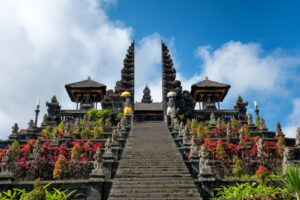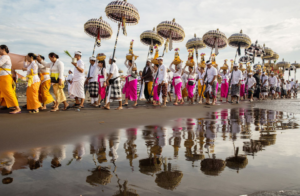Bali, known as the “Island of the Gods,” is not only renowned for its stunning beaches and vibrant culture but also for its ancient temples that dot the landscape. These sacred places of worship hold immense spiritual significance for the Balinese people and offer a glimpse into the island’s rich history and cultural heritage. In this article, we will delve into the enchanting world of Bali temples, uncovering their history, architectural beauty, and the rituals that bring them to life.
History and Significance of Bali Temples
Origins of Bali Temples

The roots of Bali’s temple culture can be traced back to ancient times when Hinduism was introduced to the island. Influenced by Indian traditions, Bali developed its unique form of Hinduism known as “Balinese Hinduism.” Temples were built as centers of religious worship and to establish a connection between the earthly realm and the divine.
Bali, with its lush landscapes, vibrant culture, and spiritual allure, became a fertile ground for the growth of Hinduism. As Indian traders and Brahmin priests arrived on the island, they brought with them the teachings of Hinduism, which began to blend with the existing animistic beliefs and ancestral worship of the Balinese people. This fusion gave rise to the distinct religious and cultural fabric of Balinese Hinduism.
Temples, known as “pura,” hold a central place in the hearts and lives of the Balinese people. They serve as physical manifestations of the spiritual world, acting as portals through which the divine can be accessed and revered. These temples are not just places of worship but also important cultural and social institutions that bring communities together.
The construction of Bali temples is a deeply revered process, guided by ancient architectural principles and religious rituals. Skilled artisans meticulously carve intricate stone sculptures, transforming simple blocks of stone into magnificent works of art. The temples are adorned with intricate carvings depicting scenes from Hindu epics, mythological figures, and symbols representing cosmic forces.
Each temple is designed with careful consideration of its surroundings. Balinese temple architecture aims to harmonize with the natural environment, creating a seamless integration between the man-made and the natural. It is not uncommon to find temples nestled amidst rice terraces, perched on cliffs overlooking the sea, or nestled within dense forests. This intentional placement serves to enhance the spiritual experience and connect worshipers with the beauty of nature.
The layout of a Bali temple typically follows a distinct pattern. The main entrance is marked by a split gate called “candi bentar,” symbolizing the division between the sacred and the profane. Beyond the entrance lies a series of courtyards, each with its own purpose and significance. The most sacred area of the temple is the innermost courtyard, which houses the main shrine or “pelinggih,” dedicated to the presiding deity of the temple.
The rituals and ceremonies performed at Bali temples are an integral part of Balinese Hinduism. They serve as a means of communication with the gods, expressing gratitude, seeking blessings, and purifying the soul. Devotees gather at the temples to participate in various religious activities, including prayers, offerings, and processions.
One of the most significant rituals conducted at Bali temples is the “piodalan” or temple anniversary celebration. Each temple has its own anniversary date, which is determined according to the Balinese calendar. During the piodalan, the temple is adorned with decorations, and elaborate ceremonies are held to honor the temple’s deities. The celebration is a grand affair, attracting devotees from nearby villages who come together to show their devotion and celebrate their shared cultural heritage.
In addition to the piodalan, Bali temples play a crucial role in various other religious festivals and ceremonies throughout the year. These include Galungan, Kuningan, Saraswati, and Nyepi, among others. Each festival carries its own significance and is celebrated with great enthusiasm, involving offerings, processions, music, dance, and community participation.
The temples also serve as educational institutions, where young Balinese are taught the religious and cultural traditions that form the foundation of their identity. Children learn the prayers, rituals, and stories associated with the temples, ensuring the continuity of Balinese Hinduism for generations to come.
Bali’s temple culture is not limited to the religious sphere; it extends to the social fabric of the island as well. Temples act as social hubs, bringing the community together for various events and gatherings. They serve as venues for weddings, funerals, and other important life ceremonies. The Balinese people take pride in their temples and actively participate in their upkeep and maintenance.
The significance of Bali temples goes beyond religious and social aspects. They are also vital for the island’s tourism industry. Bali’s temples attract visitors from around the world who are drawn to the island’s rich cultural heritage and spiritual ambiance. Travelers have the opportunity to immerse themselves in the mystical atmosphere, witness traditional ceremonies, and admire the architectural marvels.
Popular temples such as Tanah Lot, Uluwatu, Besakih, and Tirta Empul have become iconic landmarks and must-visit destinations for tourists. These temples offer breathtaking views, captivating cultural performances, and the chance to experience the profound spirituality that permeates the air.
To ensure the preservation and longevity of Bali’s temple culture, conservation efforts are undertaken by local communities, government authorities, and cultural organizations. Restoration projects are carried out to maintain the structural integrity of the temples, while regular maintenance ensures their cleanliness and upkeep. Education initiatives are also implemented to raise awareness among the younger generation about the importance of preserving their cultural heritage.
Spiritual Significance
Bali temples hold immense spiritual significance in the lives of the Balinese people, serving as sanctuaries where prayers are offered, rituals are performed, and connections with gods and ancestors are established. These temples are considered the dwelling places of deities and are revered as sacred sites that radiate positive energy, bringing solace and guidance to the community.
Within the temple grounds, devotees engage in a variety of religious activities that reflect the depth of their faith. Offerings, or “canang sari,” consisting of flowers, food, and incense, are meticulously arranged and presented to the gods as a sign of gratitude and devotion. These offerings are believed to nourish and please the deities, ensuring their continued protection and blessings upon the worshippers.
Balinese Hindus visit the temples regularly, not only for personal spiritual needs but also to partake in communal ceremonies. These ceremonies, known as “upacara,” mark significant events such as births, marriages, and funerals. The temples become vibrant hubs of activity, with the sounds of chants, music, and traditional gamelan orchestras filling the air. The Balinese come together as a community, sharing in the joyous or solemn occasions, reinforcing their social bonds and strengthening their sense of belonging.
The spiritual connection between the Balinese people and their temples goes beyond religious rituals. Temples are also places of introspection and meditation, where individuals can find solace and seek answers to life’s profound questions. Balinese Hindus believe that by immersing themselves in the sacred atmosphere of the temple, they can attain a higher level of consciousness and gain spiritual enlightenment.
The architectural beauty of Bali temples adds to their allure and magnificence. Each temple is designed with meticulous attention to detail, showcasing exquisite stone carvings, elaborate gateways, and multi-tiered pagodas. The architectural style is influenced by ancient Javanese and Indian aesthetics, reflecting the rich historical and cultural connections between these regions. The intricate carvings depict scenes from Hindu epics, symbolize cosmic forces, and represent the deities worshipped in the temple.
As the sun sets and the sky paints vibrant hues over the island, Bali temples undergo a transformation. The soft glow of flickering oil lamps, known as “pelita,” illuminates the temple compounds, creating a serene and enchanting ambiance. Devotees and visitors gather to witness mesmerizing traditional dance performances and religious ceremonies that take place during special occasions. The rhythmic movements, intricate costumes, and expressive gestures of the dancers bring to life the mythical tales and legends embedded within Balinese Hinduism.
Beyond their spiritual and cultural significance, Bali temples also contribute to the island’s tourism industry. Visitors from around the world are drawn to the magical allure of these temples, seeking an immersive experience in the island’s rich cultural heritage. The temples provide a gateway to understanding the deep-rooted traditions, rituals, and beliefs that shape Balinese society. They offer a glimpse into a world where spirituality, art, and community intersect, leaving a lasting impression on those who are fortunate enough to witness their beauty and sacredness.
Types of Bali Temples
Bali is home to a diverse array of temples, each with its own unique architectural style and purpose. These temples play a significant role in the spiritual and cultural life of the Balinese people. Let’s explore some of the prominent types of Bali temples:
Pura Puseh: These temples are known as “temples of origin” and are typically located in the heart of villages. Pura Puseh is dedicated to the ancestral spirits and is believed to protect the community and bring prosperity. They often feature intricate carvings and vibrant decorations.
Pura Dalem: Pura Dalem, or “temples of the dead,” are dedicated to the spirits of deceased ancestors. These temples serve as a place for cremation ceremonies and rituals associated with death and the afterlife. They are often adorned with elaborate stone carvings depicting scenes from Hindu mythology.
Pura Desa: Pura Desa, also known as “village temples,” are the central temples of each village. They serve as gathering places for community events, ceremonies, and religious festivals. Pura Desa plays a vital role in fostering social cohesion and unity among the villagers.
Pura Segara: These temples, also called “sea temples,” are located along the coastlines of Bali. They are dedicated to the gods and goddesses of the sea and are believed to protect fishermen and seafarers. Pura Segara offer stunning ocean views and are often visited for their serene and picturesque settings.
Pura Tirta: Pura Tirta, meaning “water temples,” are built near natural springs or water sources. These temples are believed to possess sacred water that is used for purification rituals and bathing. Pura Tirta are revered for their healing properties and spiritual significance.
Pura Padmasana: Pura Padmasana, or “temples of the highest seat,” are dedicated to Sanghyang Widi Wasa, the Supreme God in Balinese Hinduism. They serve as the central shrine within a temple complex and are considered the holiest place for spiritual connection and meditation.
Pura Kahyangan Jagat: Pura Kahyangan Jagat, meaning “temples of the world’s corners,” are strategically located in each of Bali’s cardinal directions. These temples are believed to provide spiritual protection and maintain harmony between the forces of nature. They are considered vital for the island’s overall spiritual balance.
These various types of Bali temples reflect the deep spiritual beliefs, traditions, and connections to nature that are central to Balinese Hinduism. Each temple type serves a specific purpose and contributes to the spiritual and cultural fabric of the island. Whether they are located in villages, near the sea, or by sacred water sources, Bali’s temples offer a glimpse into the rich heritage and profound devotion of the Balinese people.
Architecture and Design of Bali Temples
Elements of Balinese Architecture
Bali temples showcase exquisite architectural craftsmanship that blends seamlessly with the island’s natural surroundings. Traditional Balinese architecture incorporates elements such as meru towers, split gates (candi bentar), courtyards, and intricate stone carvings. These elements reflect the balance between the physical and spiritual realms.
Symbolism in Temple Design
The design and layout of Bali temples are rich in symbolism. The towering meru structures represent the sacred mountains, while the split gates symbolize the division between the earthly and divine realms. Intricate carvings depict mythological stories, celestial beings, and protective deities, imparting a sense of awe and reverence.
Popular Bali Temples
Tanah Lot Temple

Perched on a rocky outcrop, the iconic Tanah Lot Temple is one of Bali’s most visited temples. It is renowned for its stunning sunset views and its unique offshore setting. The temple is dedicated to the sea goddess, Dewi Danu, and is believed to offer protection to the island from evil spirits.
Uluwatu Temple

Situated atop a cliff overlooking the Indian Ocean, Uluwatu Temple is a breathtaking sight. Known for its mesmerizing sunset Kecak dance performances, the temple is dedicated to the spirits that guard the island. Visitors can also enjoy panoramic views of the ocean from the temple grounds.
Besakih Temple

Often referred to as the “Mother Temple” of Bali, Besakih Temple is the largest and most important temple on the island. Located on the slopes of Mount Agung, Bali’s highest volcano, this temple complex is a spiritual hub and a place of pilgrimage for Balinese Hindus.
Tirta Empul Temple

Pura Tirta Empul, as mentioned earlier, is a significant temple known for its holy springs. Visitors can participate in the ritual bathing and experience the cleansing and purifying process that is believed to bring spiritual renewal.
Rituals and Ceremonies at Bali Temples
Odalan Festivals
Odalan festivals are elaborate celebrations held at Bali temples to commemorate their anniversaries. These vibrant festivals involve processions, traditional music and dance performances, and offerings to the deities. The entire village comes together to honor the temple and seek blessings for the community.
Melasti Rituals

Melasti rituals are conducted before Nyepi, the Balinese Day of Silence, to cleanse the spiritual energies of the land and its people. Devotees gather at the beach or sacred springs, carrying ceremonial objects and statues of gods, to purify themselves and seek blessings for the upcoming year.
Nyepi, the Day of Silence
Nyepi is a unique cultural event in Bali when the entire island shuts down, and people observe a day of silence and introspection. Bali temples play a crucial role during Nyepi, as the day begins and ends with special ceremonies, and the Balinese seek spiritual renewal and harmony.
Balinese Hinduism and Bali Temples
Beliefs and Practices
Balinese Hinduism is a vibrant and deeply spiritual religion, woven into the fabric of everyday life. The Balinese believe in a complex cosmology that encompasses gods, ancestors, and spirits. Bali temples serve as the physical and spiritual bridges between the human and divine realms, allowing for communication
Role of Temples in Daily Life
Bali temples play an integral role in the daily lives of the Balinese people. They serve as places of worship, where individuals and families gather to offer prayers, make offerings, and seek guidance from the priests. Temples act as cultural and social centers, fostering a sense of community and unity among the Balinese people.
Preservation and Conservation of Bali Temples
The preservation and conservation of Bali temples are of utmost importance to ensure their longevity and cultural significance. Efforts are made by the local communities, government authorities, and cultural organizations to protect and maintain these sacred sites. Restoration projects, regular maintenance, and education initiatives are undertaken to preserve the architectural heritage and spiritual sanctity of the temples.
Tourist Experience at Bali Temples
Etiquette and Dress Code
When visiting Bali temples, it is essential to respect the sacredness of the place and adhere to the local customs. Modest attire is required, with shoulders and knees covered. Sarongs and sashes are often provided at the temple entrances for visitors to wear as a sign of respect.
Temple Visit Tips
To make the most of your temple visit, consider the following tips:
- Research and choose temples that align with your interests and preferences.
- Hire a knowledgeable guide who can provide insights into the temple’s history and significance.
- Visit during quieter times to avoid large crowds and experience a more serene atmosphere.
- Follow the instructions and guidelines provided by the temple authorities and respect any restricted areas.
- Capture the beauty of the temples through photography while being mindful not to disturb the rituals or other visitors.
Bali temples are not merely architectural wonders but living embodiments of the island’s rich cultural heritage and spiritual traditions. They offer a profound glimpse into the Balinese way of life and their devotion to their gods and ancestors. From the awe-inspiring architecture to the vibrant rituals and ceremonies, each temple tells a unique story and leaves a lasting impression on visitors.
As you explore Bali’s temples, immerse yourself in the mystical ambiance, participate in rituals with reverence, and embrace the spiritual essence that permeates these sacred sites. Discover the harmonious blend of art, architecture, and devotion that has made Bali temples a cherished treasure and a must-visit destination for spiritual seekers and culture enthusiasts alike.
FAQs (Frequently Asked Questions)
What is the best time to visit Bali temples?
The best time to visit Bali temples is during the early morning or late afternoon when the weather is cooler, and the lighting is ideal for photography. However, it is important to check the temple’s opening hours and any specific timings for ceremonies or rituals.
Can non-Hindus visit Bali temples?
Yes, non-Hindus are welcome to visit Bali temples and experience their beauty and spirituality. It is important to show respect for the religious practices and dress modestly to adhere to the temple’s customs.
Are there any entrance fees for visiting Bali temples?
Some temples may charge a nominal entrance fee to help with the maintenance and preservation of the site. The fees are typically used for the temple’s upkeep and to support the local community.
Are there any restrictions for photography at Bali temples?
While photography is generally allowed at Bali temples, it is important to be mindful of the sanctity of the place and the ongoing rituals. Respect any restricted areas or signs indicating no photography, and always ask for permission before photographing individuals or priests.
How can I participate in a temple ceremony?
To participate in a temple ceremony, it is recommended to connect with a local guide or seek information from the temple authorities. They can provide guidance on the appropriate rituals, dress code, and timings for attending ceremonies. Respectful participation in a temple ceremony can allow you to witness the spiritual fervor and cultural richness of Bali’s temple traditions. Remember to approach the ceremonies with humility and reverence, following the instructions of the priests and showing respect for the Balinese customs and rituals.
Now is the time to embark on a spiritual and cultural journey to Bali’s magnificent temples. Immerse yourself in the mystical atmosphere, witness ancient rituals, and discover the profound beauty that lies within these sacred sites. Don’t miss the opportunity to explore the enchanting world of Bali temples and experience the transformative power they hold.
For visit Bali’s Temple, contact us for reservation:
